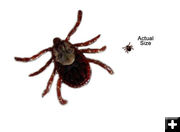Ticks are out
April 9, 2020
As if coronavirus wasnt enough to think about right now, our health care providers are passing along the notice that ticks are out. Ticks are insects that are found in the wild, coming out in early spring. They can get on people and pets and not be detected even after having bitten and embedded themselves onto the skin. Ticks carry a virus called Colorado Tick Fever, which can cause severe illness. According to the Wyoming Department of Health, Sublette County has had the highest incidence of Colorado Tick Fever in the nation since 2000.
Click on this link to read more about Colorado Tick Fever from the Wyoming Department of Health.
________________________________________
What is Colorado Tick Fever?
Colorado Tick Fever (CTF) is an acute viral infection transmitted from the bite of an infected wood tick (Dermacentor andersoni). The virus is transmitted mainly in the western United States and Canada. Wood ticks are found primarily in regions with mountainous terrain from 4,000 10,000 feet elevations. In Wyoming CTF transmission occurs primarily during the months of May through August and have been reported primarily in the south and western part of the state. Sublette County has had the highest incidence of CTF in the nation since 2000.
How do people get Colorado Tick Fever?
Most human infections are acquired from adult ticks. Transmission is seasonal and closely parallels the active tick season in summer and fall. CTF is not known to be transmitted person to tick to person, but because it stays in the bloodstream for a long period of time, it is theoretically possible. Transmission of CTF through blood transfusion has been documented, but only once since 1944 when the virus was first isolated from human blood. Additionally, CTF can be passed from mother to infant in pregnant women.
What are the symptoms?
Symptoms can include sudden onset of fever, chills, headache, pain behind the eyes, light sensitivity, muscle pain, and general fatigue. Symptoms such as nausea, vomiting, and abdominal and respiratory problems can occur but are less common. Flat or pimply rashes occur in about 15% of cases. Acute symptoms generally resolve within a week, but in some cases, patients experience recurrent symptoms every 2 to 3 days for a couple weeks resulting in a diphasic fever or relapse.
How is CTF diagnosed?
A diagnosis of CTF is based on a combination of clinical signs and symptoms and specialized confirmatory laboratory tests, including antibody assays and cell culture. Other common laboratory findings suggestive of CTF fever include leukopenia (decreased white blood cells), thrombocytopenia (decrease in blood platelets) and mildly elevated liver enzyme levels. Your healthcare provider will determine if laboratory testing is needed.
What is the treatment for CTF?
There is no treatment for CTF infection, only supportive therapy. Antivirals have been evaluated, but none have shown specific benefit. There is no vaccine for this disease. Infection with CTF is thought to provide long lasting immunity against re-infection. However, prior illness with CTF should not deter persons from practicing good tick-preventive measures or visiting a physician if signs and symptoms consistent with CTF occur, especially following a tick bite.
How can tick-borne diseases be prevented?
Limiting exposure to ticks reduces the likelihood of CTF virus infection. Tick-infested habitats should be avoided. In Wyoming, that would be areas of heavy sage brush. Additional prevention measures include:
Use pest collars or treatments on dogs and cats that are allowed to roam outside. Speak with your veterinarian for recommendations on specific products.
Wear light-colored clothing to allow you to see ticks that are crawling on your clothing.
Tuck your pants legs into your socks so that ticks cannot crawl up the inside of your pants legs.
Wear long sleeves and tuck your shirt into your pants
Apply repellents to discourage tick attachment. Repellents containing permethrin can be sprayed on boots and clothing. Repellents containing 20% or more DEET (n, n-diethyl-m-toluamide) can also help deter ticks.
Perform tick checks on humans and pets immediately upon returning from outings.
And finally, prompt and proper tick removal is essential.
To remove attached ticks, use the following procedure:
1. Use fine-tipped tweezers or shield your fingers with a tissue, paper towel, or rubber gloves. When possible, persons should avoid removing ticks with bare hands.
2. Grasp the tick as close to the skin surface as possible and pull upward with steady, even pressure. Do not twist or jerk the tick; this may cause the mouth-parts to break off and remain in the skin. (If this happens, remove mouth-parts with tweezers. Consult your health care provider if infection occurs.)
3. Do not squeeze, crush, or puncture the body of the tick because its fluids (saliva, body fluids, gut contents) may contain infectious organisms.
4. After removing the tick, thoroughly disinfect the bite site and wash your hands with soap and water.
5. Save the tick for identification in case you become ill. This may help your doctor make an accurate diagnosis. Place the tick in a plastic bag and put it in your freezer. Write the date of the bite on a piece of paper with a pencil and place it in the bag.
Folklore remedies, such as the use of petroleum jelly or hot matches, do little to encourage a tick to detach from skin. In fact, they may make matters worse by irritating the tick and stimulating it to release additional saliva or regurgitate gut contents, increasing the chances of transmitting the pathogen. These methods of tick removal should be avoided.
|
